NCERT Exemplar Class 11 Physics Chapter 5 Work, Energy and Power are part of NCERT Exemplar Class 11 Physics . Here we have given NCERT Exemplar Class 11 Physics Chapter 5 Work, Energy and Power.
NCERT Exemplar Class 11 Physics Chapter 5 Work, Energy and Power
Multiple Choice Questions
Single Correct Answer Type
Q1. An electron and a proton are moving under the influence of mutual forces. In calculating the change in the kinetic energy of the system during motion, one ignores the magnetic force of one on another. This is, because
(a) the two magnetic forces are equal and opposite, so they produce no net ‘ effect
(b) the magnetic forces do not work on each particle
(c) the magnetic forces do equal and opposite (but non-zero) work on each particle
(d) the magnetic forces are necessarily negligible
Sol:
(b)
Key concept: To calculate the change in kinetic energy of the system during motion we have to apply work-energy, theorem. According to this theorem, Net work done = Final kinetic energy – Initial kinetic energy of the object The above statement shows the connection between work and kinetic energy as: “The work done by the net force acting on an object is equal to the change in the kinetic energy of that object”.
Net work done (IF) on a particle equals change in kinetic energy of the particle.
ΣW=K 2 -K 1
According to the problem as the electron and proton are moving under the influence of mutual forces, the magnetic forces will be perpendicular to their motion, hence, it acts as a centripetal force for the particle. In this way the particle performs the uniform circular morion, this implies speed will remain constant. So, there is no change in kinetic energy of the particle. Hence no work is done by these forces.

(magnetic force) will be perpendicular to both B and v, where B is the external magnetic field and v is the velocity of particle. That is why one ignores the magnetic force of one particle on another.
Q2. A proton is kept at rest. A positively charged particle is released from rest at a distance d in its field. Consider two experiments; one in which the charged particle is also a proton and in another, a positron. In the same time t, the work done on the two moving charged particles is
(a) same as the same force law is involved in the two experiments
(b) less for the case of a positron, as the positron moves away more rapidly and the force on it weakens
(c) more for the case of a positron, as the positron moves away a larger distance
(d) same as the work done by charged particle on the stationary proton
Sol:
(c) Force between two protons is equal to the force between proton and a
positron because their charges are same. As the mass of positron is much lesser than proton, (1/1840 times) it moves away through much larger distance compared to proton.
Change in their momentum will be same. So, velocity of lighter particle will be greater than that of a heavier particle. So, positron is moved through a larger distance.
As work done = force x distance. As forces are same in case of proton and positron but distance moved by positron is larger, hence, work done will be more.
Q3. A man squatting on the ground gets straight up and stand. The force of reaction of ground on the man during the process is
(a) constant and equal to mg in magnitude
(b) constant and greater than mg in magnitude
(c) ‘ variable but always greater than mg
(d) at first greater than mg and later becomes equal to mg
Sol:
(d) In the process of squatting on the ground he gets straight up and stand. Then he is tilted somewhat, the man exerts a variable force on the ground to balance his weight, hence he also has to balance frictional force besides his weight in this case.
N = Normal reaction force = friction + mg => N > mg
Once the man gets straight up that variable force = 0 =>
Normal reaction force = mg
Q4. A bicyclist comes to a skidding stop in 10 m. During this process, the force on the bicycle due to the road is 200 N and is directly opposed to the motion. The work done by the cycle on the road is
(a) +2000 J
(b) -200 J
(c) zero
(d) -20,000 J
Sol:
(c) As the friction is present in fhis problem, so mechanical energy is not conserved. So energy will be lost due to dissipation by friction.^Here, work is done by the frictional force on the cycle and is equal to __
200 x 10 = -2000 J
As the road does not move at all, therefore, work done by the cycle on the road is zero.
Important point: We should be aware that here the energy of bicyclist is lost during the motion, but it is lost due to friction in the form of heat.
Q5. A body is falling freely under ‘the action of gravity alone in vacuum. Which of the following quantities remain constant during the fall?
(a) Kinetic energy
(b) Potential energy
(c) Total mechanical energy
(d) Total linear momentum
Sol:
(c) As the body is falling freely under gravity, the potential energy decreases continuously and kinetic energy increases continuously as all the conservative forces are doing work. So, total mechanical energy (PE + KE) of the body will be constant.
Let us discuss this in detail:
In the given diagram an object is dropped from-a height H from ground.
At point A total mechanical energy will be EA = K.E + P.E
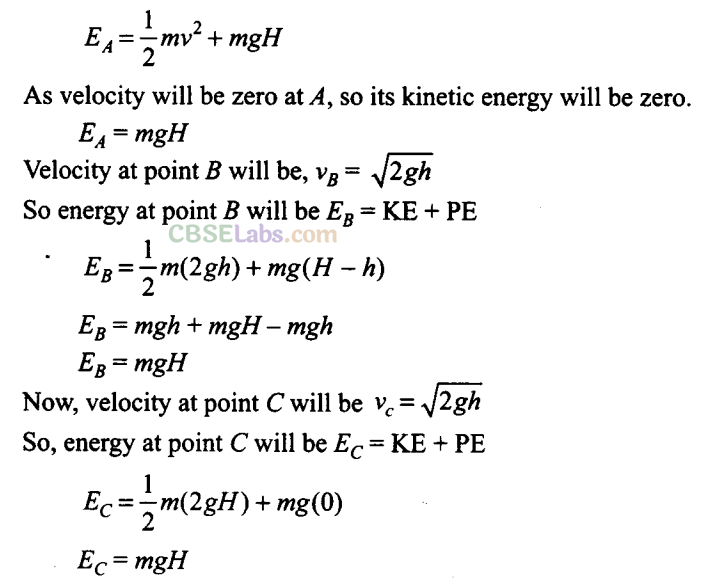
So, total mechanical energy will remain same (if we neglect the air friction).
Q6. During inelastic collision between two bodies, which of the following quantities always remain conserved?
(a) Total kinetic energy
(b) Total mechanical energy
(c) Total linear momentum
(d) Speed of each body
Sol:
(c) If in a collision kinetic energy after collision is not equal to kinetic energy before collision, the collision is said to inelastic.
Coefficient of restitution 0 < e < 1
When we are considering the two bodies as system the total external force on the system will be zero.
Hence, total linear momentum of the system remain conserved.
Here kinetic energy appears in other forms, i.e. energy may be lost in the form of heat and sound etc. In some cases
(KE)
final
< (KE)
initial
such as when initial KE is converted into intertial energy of the product (as heat, elastic or excitation) while in other cases (KE)
final
> (KE)
initial
such as when internal energy stored in the colliding particles is released.
Examples’. (1) Collision between two billiard balls.
(2) Collision between two automobiles on a road.
In fact all majority of collisions belong to this category.
Q7. Two inclined ffictionless tracks, one gradual and the other steep meet at A from where two stones are allowed to slide down from rest, one on each track as shown in figure.
Which of the following statement is correct?
(a) Both the stones reach the bottom at the same time but not with the same speed.
(b) Both the stones reach the bottom with the same speed and stone I reaches the bottom earlier than stone II.
(c) Both the stones reach the bottom with the same speed and stone II reaches the bottom earlier than stone I.
(d) Both the stones reach the bottom at different times and with different speeds.
Sol:
(c) As shown in diagram AB and AC are two smooth planes inclined to the angle θ
1
and θ
2
respectively. As friction is absent here, hence, mechanical energy will be conserved. As both the tracks having common height h,
From conservation of mechanical energy,
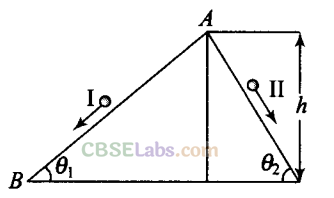
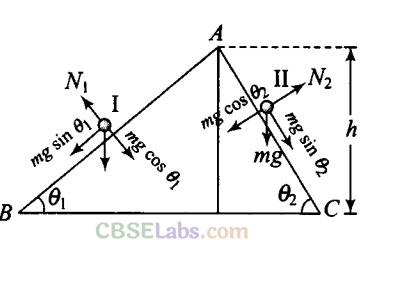
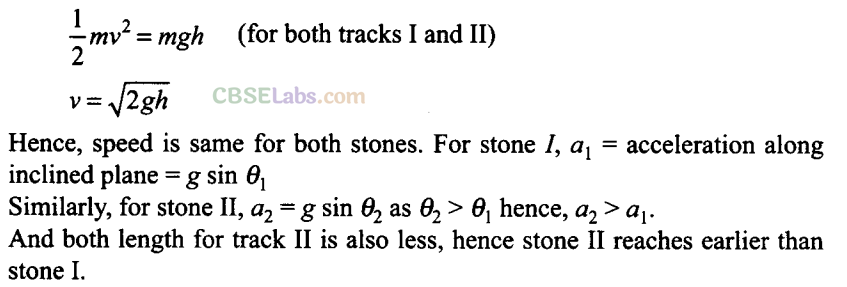
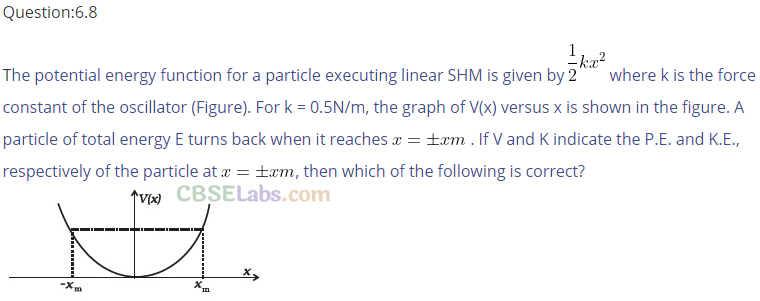
(a) V=0,K = E
(b) V=E,K=0
(c) V< E, K= O
(d) V= 0,K<E
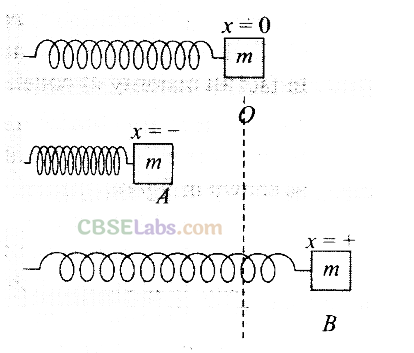
Sol:
(b)
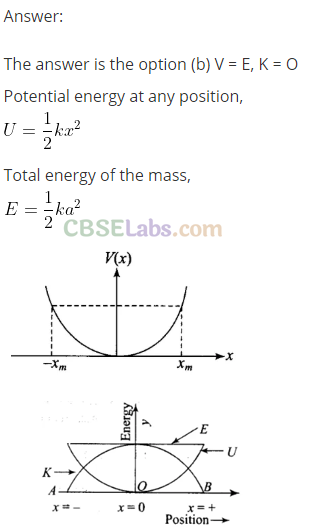
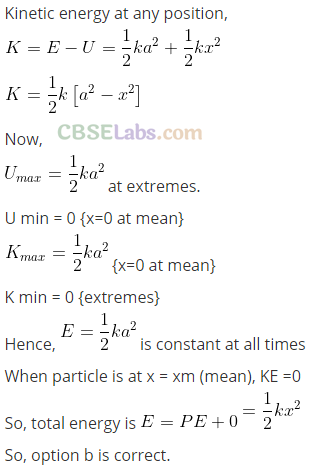
Q9. Two identical ball bearings in contact with each other frictionless table are hit head-on by another ball bearing of the same mass moving initially with a speed v as shown in figure.
If the collision is elastic, which of the following (figure) is a possible result after collision?
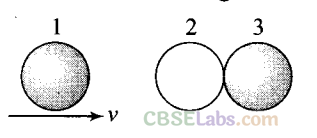
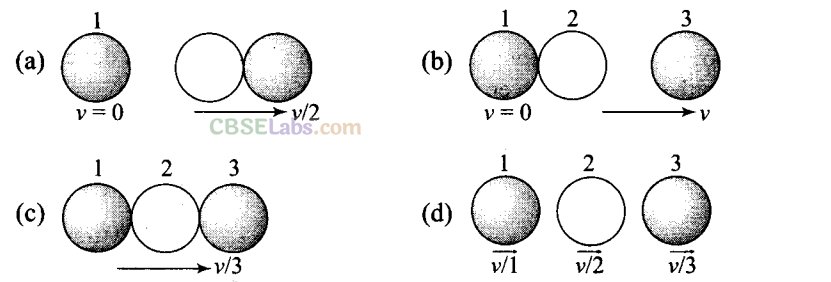
Sol:
(b)
Key concept: In a collision if the motion of colliding particles before and after the collision is along the same line, the collision is said to be head on or one dimensional.
When two bodies of equal masses collides elastically, their velocities are interchanged.
Kinetic energy and linear momentum remains conserved Total kinetic energy of the system before collision
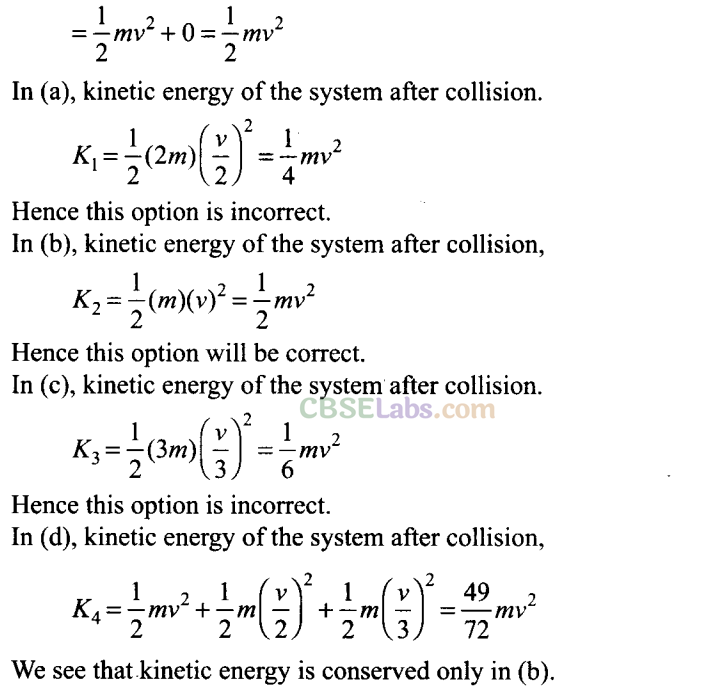
Q10. A body of mass 0.5 kg travels in a straight line with velocity v = ax 3/2 where a = 5 m -1/2 s _1 . The work done by the net force during its displacement from x = 0 to; x = 2m is
(a) 5 J
(b) 50 J
(c) 10 J
(d) 100 J
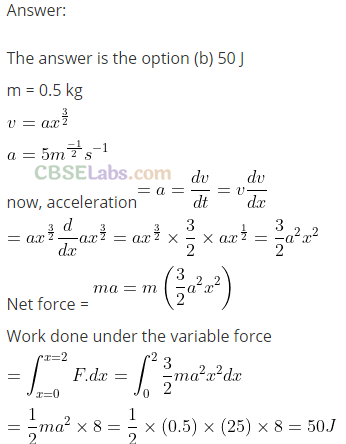
Q11. A body is moving unidirectionally under the influence of a source of constant power supplying energy. Which of the diagrams shown in figure correctly shown the displacement-time curve for its motion?
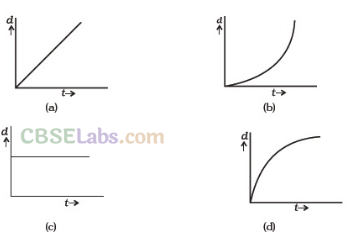
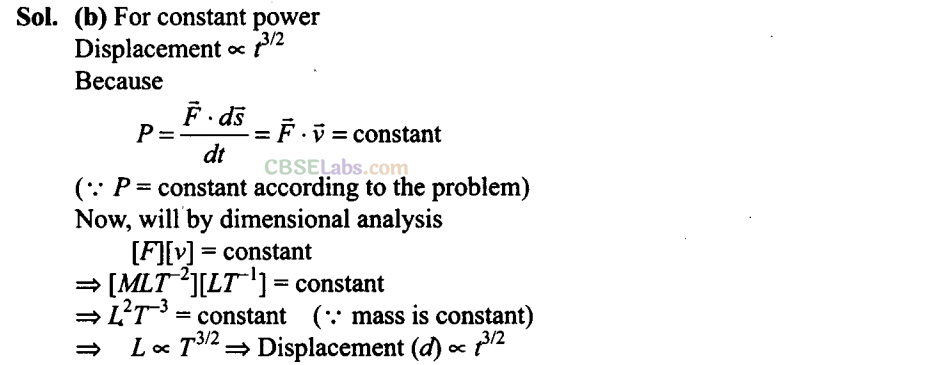
Q12. Which of the diagrams shown in figure most closely shows the variation in kinetic energy of the earth as it moves once around the sun in its elliptical orbit?
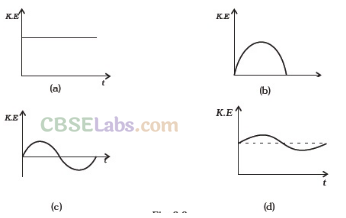
Sol:
(d) As the earth moves once around the sun in its elliptical orbit, when the earth is closest to the sun, speed of the earth is maximum, hence KE is maximum. When the earth is farthest from the sun speed is minimum, hence KE is minimum but never zero and negative.
This variation of KE vs t is correctly represented by option (d).
Q13. Which of the diagrams in figure represents varation of total mechanical energy of a pendulum oscillating in air as functon of time?
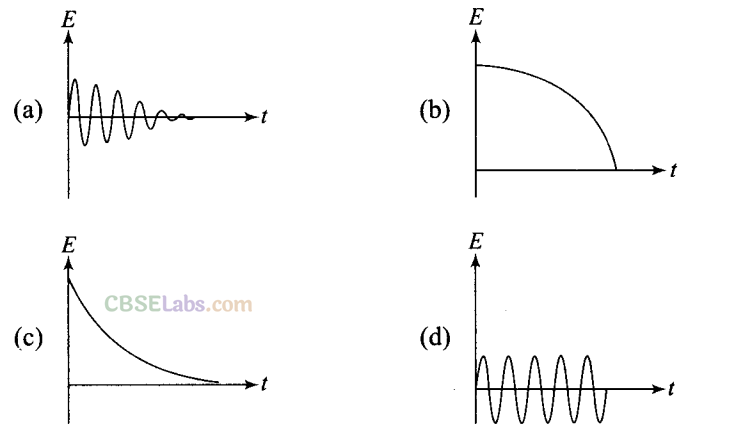
Sol:
(c) When a pendulum oscillates in air, its total mechanical energy decreases continuously in overcoming resistance due to air. Therefore, total mechanical energy of the pendulum decreases exponentially with time.
The variation of E vs t is correctly represented by curve (c) in which the relation between energy and time is shown.
Q14. A mass of 5 kg is moving along a circular path of radius 1 m. If the mass moves with 300 rev/min, its kinetic energy would be
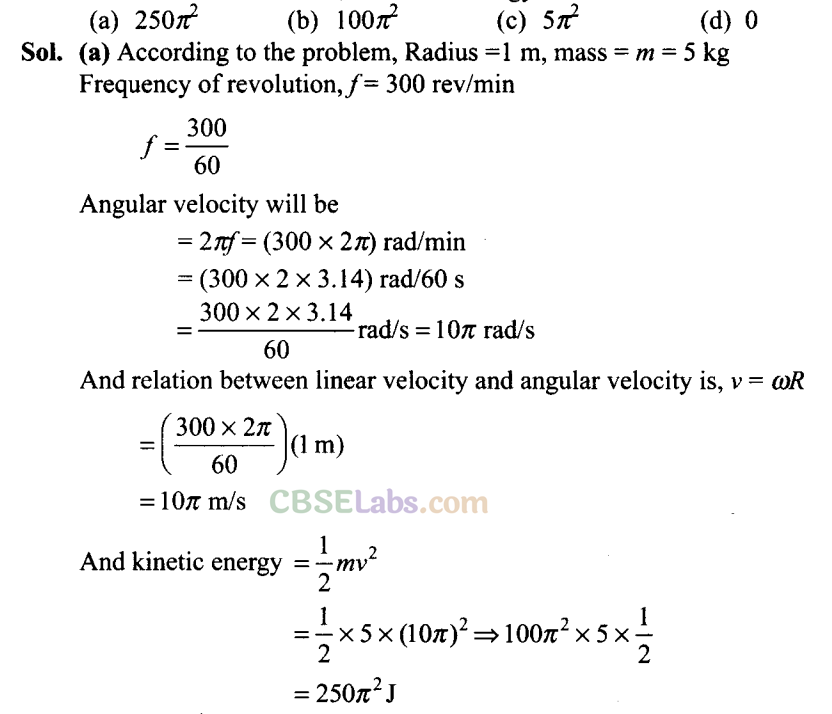
Q15. A raindrop falling from a height h above
ground
,
attains a near terminal velocity when it has fallen through a height (3/4)h. Which of the diagrams shown in figure correctly shows the change in kinetic and potential energy of the drop during its fall up to the ground?
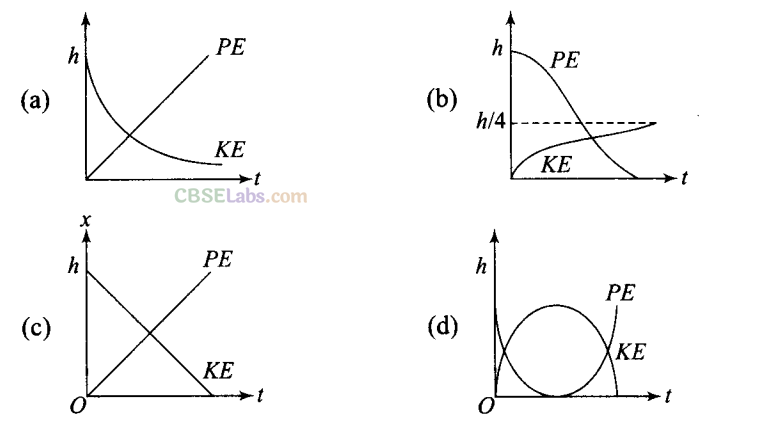
Sol:
(b) At height h from ground raindrop have maximum potential energy. And kinetic velocity will be zero (at the instant when it dropped its velocity will be zero), then as the rain drop falls its PE starts decreasing and kinetic energy start increasing.
The total mechanical energy will remain conserved if we neglect the air resistance. If there is some air resistance, there is some force called upthrust (in fluids) which opposes its motion. It depends upon velocity of object as the velocity increases, upthrust also increases. Hence during fall of raindrop first its velocity increases and then become constant after some time.
This constant velocity is called terminal velocity, hence KE also become constant. PE decreases continuously as the drop is falling continuously.
The variation in PE and KE is best represented by (b).
Q16. In a shotput event an athlete throws the shotput of mass 10 kg with an initial speed of 1 m s
-1
at 45° from a height 1.5 m above ground. Assuming air resistance to be negligible and acceleration due to gravity to be 10 m s
-2
, the kinetic energy of the shotput when it just reaches the ground will be
(a) 2.5 J
(b) 5.0 J
(c) 52.5 J
(d) 155.0 J
Sol:
(d) If air resistance is negligible, total mechanical energy of the system will remain constant. And let us take ground as a reference where potential energy will be zero.
According to the problem, h = 1.5 m, v = 1 m/s, m = 10 kg, g = 10 ms
–
2
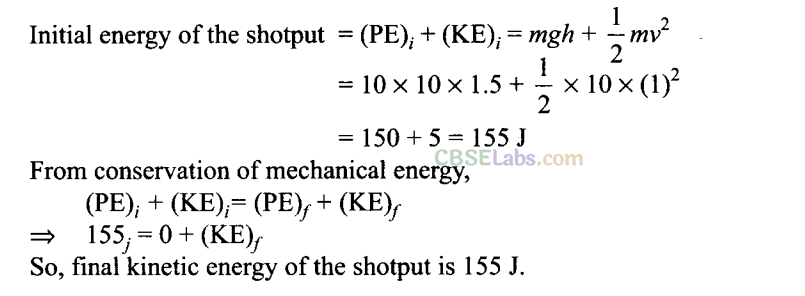
Q17. Which of the diagrams in figure correctly shows the change in kinetic energy of an iron sphere falling freely in a lake having sufficient depth to impart it a terminal velocity?
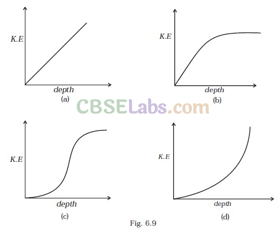
Sol:
(b) When an iron sphere is falling freely in the lake, it will accelerate by the force due to gravity then its velocity increases continuously and resistance due to water cause a force called viscous force or upthrust (in fluids) which opposes its motion. It depends upon velocity of object as the velocity increases upthrust increases. Hence during fall of sphere first its velocity increases and then become constant after some depth.
This constant velocity is called terminal velocity, hence KE become constant beyond this depth, which is best represented by (b).
Q18. A cricket ball of mass 150 g moving with a speed of 126 km/h hits at the middle of the bat, held firmly
at
its position by the batsman. The ball moves straight back to the bowler after hitting the bat. Assuming that collision between ball and bat is completely elastic and the two remain in contact for0.001 s, the force that the batsman had to apply to hold the bat firmly
at
its place would be
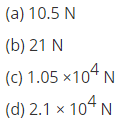
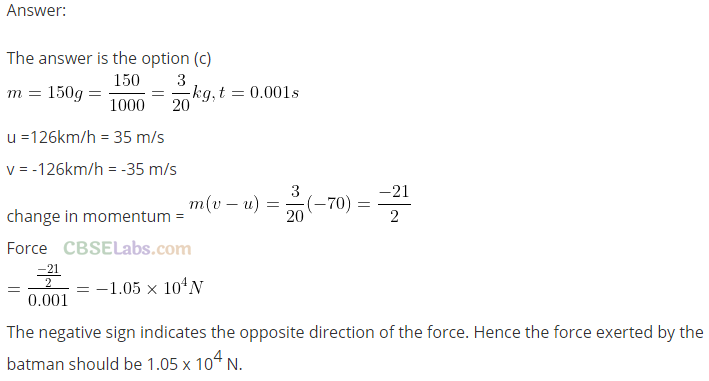
More Than One Correct Answer Type
Q19. A man of mass m, standing at the bottom of the staircase, of height
L
climbs it and stands at its top.
(a) Work done by all forces on
man
is equal to the rise in potential energy mgL.
(b) Work done by all forces on
man
is zero.
(c) Work done by the gravitational force on
man
is mgL.
(d) The reaction force from a step does not do work because the point of application of the force does not move while the force exists.
Sol:
(b, d) When a man of mass m climbs up the staircase of height L, work done by the gravitational force on the man = -mgL
Work done by internal muscular forces = -Work done against gravitational force = mgL
Work done by all the forces = mgL – mgL = 0
As the point of application of the contact forces does not move, hence work done by reaction forces will also be zero.
And work done by friction will also be zero as there a no dissipation or rubbing is involved.
Q20. A bullet of mass m fired at 30° to the horizontal leaves the barrel of the gun with a velocity v. The bullet hits a soft target at a height h above the ground while it is moving downward and emerge out with half the kinetic energy it had before hitting the target.
Which of the following statements are correct in respect of bullet after it emerges out of the target?
(a) The velocity of the bullet will be reduced to half its initial value.
(b) The velocity of the bullet will be more than half of its earlier velocity
(c) The bullet will continue to move along the same parabolic path.
(d) The bullet will move in a different parabolic path.
(e) The bullet will fall vertically downward after hitting the target.
(f) The internal energy of the particles of the target will increase.
Sol:
(b, d, f) The given situation is shown in the diagram. Let speed after emerging from the target is v”, v’ is speed of the bullet just before hitting the target, v is the initial speed of bullet
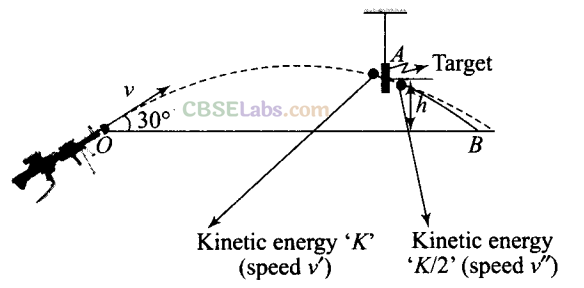
(a) The velocity of the bullet after it emerges out of the target will be reduced to half its initial value.
Compare the kinetic energies before and after hitting the target.Just before hitting the target the mechanical energy will be conserved. After hitting its energy will be loose. So by conservation of mechanical energy between “O” and “A” (A is the point where the target is placed),
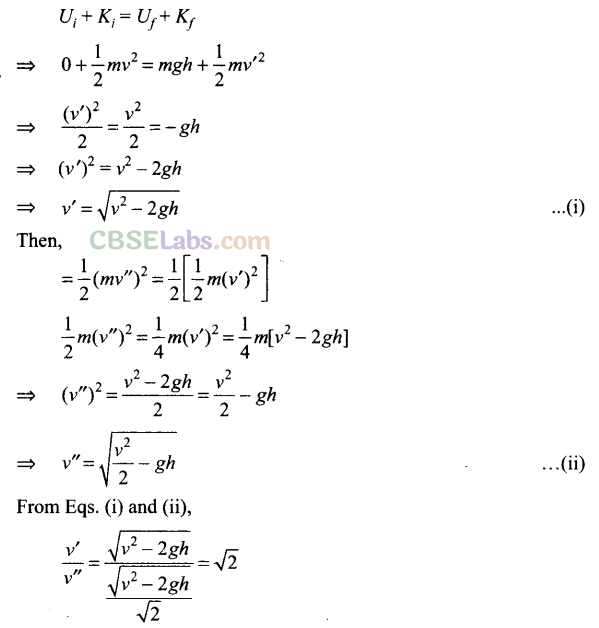
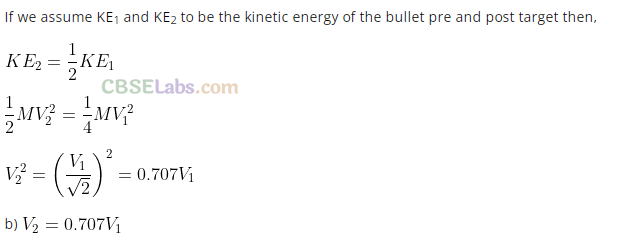
Hence, after emerging from the target velocity of the bullet (v”) is more than half of its earlier velocity v’ (velocity before emerging into the target). So option (b) is correct.
(c) Since velocity of the bullet is changed after hitting the target, so it follows a different parabolic path.
(d) As the velocity of the bullet changes to v’which is less than v’ hence path followed will change and the bullet reaches at point B instead of A’, as shown in the figure.
(e) After emerging from the target, bullet follows a parabollic path, the bullet will not fall vertically downward, so it is an incorrect option.
(f) As the bullet is passing through the target, the loss in energy of the • bullet is transferred to particles of the target. Therefore, their internal energy increases.
Q21. Two blocks M
1
and M
2
having equal mass are free to move on a horizontal frictionless surface. M
2
is attached to a massless spring as shown in
figure
.
Initially
M
2
is at rest and A/, is moving toward M
2
with speed v and collides head-on with M
2
.
(a) While spring is fully compressed all the KE of
Myis
stored as PE of spring.
(b) While spring is fully compressed the system momentum is not conserved, though final momentum is equal to initial momentum.
(c) If spring is massless, the final state of the M
1
is state of rest.
(d) If the surface on which blocks are moving has friction, then collision cannot be elastic
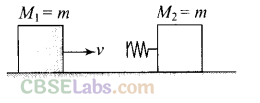
Sol:
(c, d) If there is not specified we always consider the collision elastic.
When two bodies of equal masses collides elastically, their velocities are interchanged in these types of collision.
Kinetic energy and linear momentum remain conserved.
According to the above diagram when m
1
comes in contact with the spring, m
1
is retarded by the spring force and m
2
is accelerated by the spring force.
(a) The spring will continue *to compress until the two blocks acquire common velocity. So some of kinetic energy of block M
x
store into P.E and some part of it stores into K.E of block M
2
. So option (a) is incorrect.
(b) As surfaces are frictionalless momentum of the system will be conserved. So option (b) is also incorrect.
(c) The two bodies of equal mass exchange their velocities in a head on elastic collision between them. So, if spring is massless, the final state of the M
1
is state of rest.
(d) Since there is a loss of K.E when the blocks collides on the rough surface. Hence, the collision is inelastic.
Very Short Answer Type Questions
Q22. A rough inclined plane is placed on a cart moving with a constant velocity u on horizontal ground. A block of mass M rests on the incline. Is any work done by force of friction between the block and incline? Is there then a dissipation of energy?
Sol:
Let us consider the diagram according to the situation. Just imagine the situation that wedge is moving with velocity u. As the block Mis at rest with respect to the inclined plane. There is no pseudo force acting on the block because the wedge is moving with constant velocity. So,
f = frictional force = Mg sinθ (upward as shown in the figure)
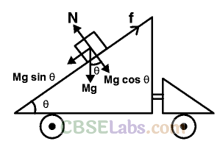
As the block rests on the incline, the force of friction acting between the block and the incline opposes the tendency of sliding of the block. Since, block is not in motion with respect to incline, therefore, work done by the force of friction between the block and the inclined plane is zero. Also due to this reason there is no dissipation of energy.
Q23. Why is electrical power required at all when the elevator is descending? Why should there be a limit on the number of passengers in this case?
Sol:
When the elevator is descending, then electric motor (mainly induction motor are used) provides some force to overcome the weight of elevator to prevent it from falling freely under gravity, then electric power is required to run electric motor which is holding the elevator via cable to prevent it from falling freely. This cable is able to sustain some limiting value of tension developed in it. Due to this reason, it is needed to limit the number of passengers in the elevator.
Q24. A body is being raised to a height h from the surface of
earth
. What is the sign of work done by
(a) applied force and (b) gravitational force?
Sol:(a)
External force is applied on the body to lift it in upward direction against its weight, therefore, angle between the applied force and displacement is = 0°
Work done by the applied force
W= F. S =Fs cos = Fs cos 0° = Fs ( cos 0° = 1)
i.e., the sign of work done by applied force is positive.
(b)
As shown in figure the gravitational force acts in downward direction and displacement in upward direction, therefore, angle between them is = 180°.
Work done by the gravitational force
W = Fs cos 180° = -Fs (cos 180° = -1)

Q25. Calculate the work done by a car against gravity in moving along a straight horizontal road. The mass of the car is 400 kg and the distance moved is 2 m.
Sol:
Weight of the car (mg) vertically downward and car is moving along horizontal road, so displacement of the car is in the along horizontal, i.e. angle between them is 90°.
Work done by weight of the car
W = Fs cos 90° = 0 (cos 90° = 0)
Hence, the work done by car against gravity will also be zero.
Q26. A body falls towards earth in
air
. Will its total mechanical energy be conserved during the fall? Justify.
Sol:
If we neglect the air resistance then the total mechanical energy of the body is conserved but if there is some air resistance then a small part of its energy is utilized against resistive force of air, which is non-conservative force. So, total mechanical energy of the body falling freely under gravity in this case is not conserved. In this condition, gain in KE < loss in PE.
Let E be the total mechanical energy.
Initial mechanical energy of the body

Q27. A body is moved along a closed loop. Is the work done in moving the body necessarily zero? If not, state the condition under which work done over a closed path is always zero.
Sol:
Key concept: If the work done by a force on a body depends upon the initial and final positions only of that body, then the force is conservative e.g., gravitational, electrostatic, magnetic forces.
If the work done by a force on a body which has moved in closed path and has come back to its initial position is zero, the force is conservative.
Work done in moving along a closed loop is not always zero. Work done in moving a closed path is zero when forces acting on the body are conservative but for non-conservative forces like friction force, viscous force etc. work done in a closed path is not zero.
Q28. In an elastic collision of two billiard balls, which of the following quantities remain conserved during the short time of collision of the balls (i.e., when they are in contact)?
(a) Kinetic energy
(b) Total linear momentum
Give
reason
for your answer in each case.
Sol:
During collision no external force is acting on the balls, therefore total linear momentum of the system of two balls is always conserved.
During collision when the balls are in contact, there may be deformation, hence some kinetic energy of system will be transformed to potential energy of system and consequently kinetic energy will not be conserved.
Important point: Though kinetic energy of system will not be conserved but total energy of the system will be conserved.
Q29. Calculate the power of a crane, in watts, which lifts a mass of 100 kg to a height of 10 m in 20 s.
Sol:
According to the problem, mass = m= 100 kg height = h- 10 m, time interval, t = 20 s Power is the rate of doing work with respect to time.
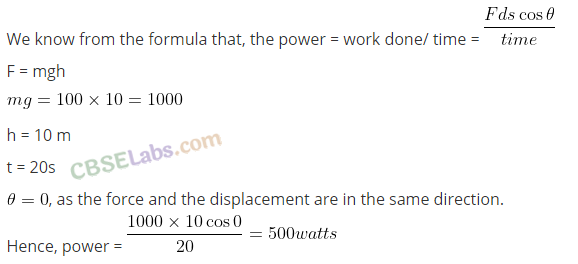
Q30. The average work done by a human heart while it beats once is 0.5 J. Calculate the power used by heart if it beats 72 times in a minute.
Sol:
According to the problem, average work done by a human heart per beat = 0.5 J
Total work done during 72 beats in 1 minute
= 72 x 0.5 J =36 J
Power = Work done = 36 J / 60s = 0.6 w
Q31. Give
example
of a situation in which an applied force does not result in a change in kinetic energy.
Sol:
Assume a ball tied to a string and is moving in a vertical circle. Work done by tension force will be zero and hence tension force will not cause any change in KE of ball. Because at any instant of time the displacement is tangential and the force is central in nature, i.e., tension in the string and the small displacement at any instant are perpendicular to each other.
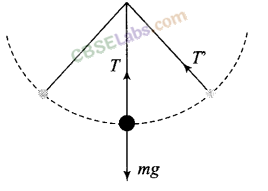
Q32. Two bodies of unequal mass are moving in the same direction with equal kinetic energy. The two bodies are brought to rest by applying
retarding
force of
same
magnitude. How would the distance moved by them before coming to rest compare?
Sol:
According to work-energy theorem,
Change in KE is equal to work done by all the forces acting on the body. Let us assume that only one force (retarding force) is acting on the body, therefore,
KE of the body = Work done by retarding force KE of the body = Retarding force x Displacement
As KE of the bodies and retarding forces applied on them are same, therefore, both bodies will travel equal distances before coming to rest.
Q33. A bob of mass m suspended by a light string of length L is whirled into a vertical circle as shown in figure . What will be the trajectory of the particle, if the string is cut at
- Point B?
- Point C?
- Point A?
Sol:
Key concept: According to the situation shown above that a bob of mass m is whirled into a vertical circle, the required centripetal force is obtained from the net force towards center at any point of time in the string. Tension in the string is variable and it is always towards center. But the gravitational force on the bob is always towards center. The speed of the body will be different at different points. So the equations of dynamical equilibrium (F
c
= ma
c
, F
t
= ma
t
) must be satisfied at all the points. Let when the string makes an angle 9 with vertical, the speed of mass is v.
Apply Newton’s law perpendicular to the string:
Mg sin = ma, => a,= g sin
The above equation gives tangential acceleration as a function of angle . At lowest point = 0° and at highest point = 180°. So at both points sin 9=0. Hence a, = 0 at both points L and H.
At point M, = 90°, then a
1
= g. It is the maximum value of a
t
Apply Newton’s law along the string: T – mg cos = ma
c
or
T=mgcos + m v
2
/r
…(i)
As the body goes up, its velocity will go on decreasing and angle θ will go on increasing. Maximum speed of the body will be at lowest point L and minimum at highest point H. Then from above relation we can find that tension will be maximum at lowest point and minimum at highest point.
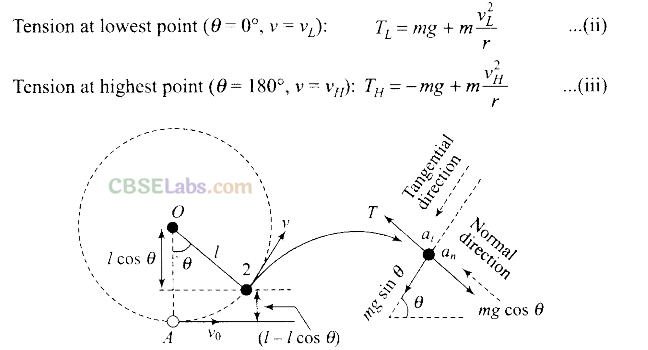
When string is cut, tension in string becomes zero and centripetal force is not provided. Hence, bob tends to move in along the direction of its velocity.
(a) If the string is cut at any point, then velocity of body of mass m is along the tangent to the circle. Tangent at point B is vertically downward so the trajectory of the particle is the straight line.
(b) Tangent at point C is horizontally towards right.
So the trajectory of the particle is the parabola.
(c) Tangent at point X makes some angle with the horizontal. Again bob will follow a parabolic path with vertex higher than C.
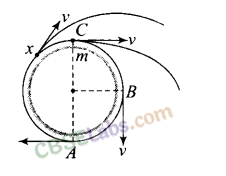
NCERT Exemplar Class 11 Physics Solutions
- Chapter 1 Units and Measurements
- Chapter 2 Motion in a Straight Line
- Chapter 3 Motion in a Plane
- Chapter 4 Laws of Motion
- Chapter 5 Work, Energy and Power
- Chapter 6 System of Particles and Rotational Motion
- Chapter 7 Gravitation
- Chapter 8 Mechanical Properties of Solids
- Chapter 9 Mechanical Properties of Fluids
- Chapter 10 Thermal Properties of Matter
- Chapter 11 Thermodynamics
- Chapter 12 Kinetic Theory
- Chapter 13 Oscillations
- Chapter 14 Waves